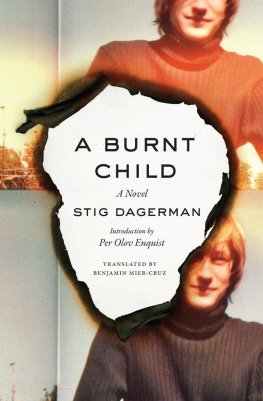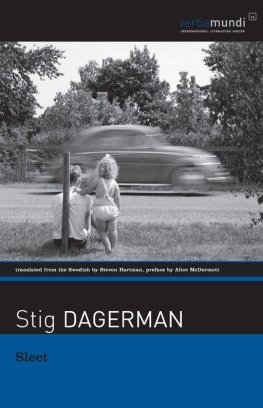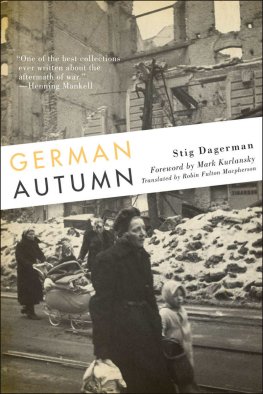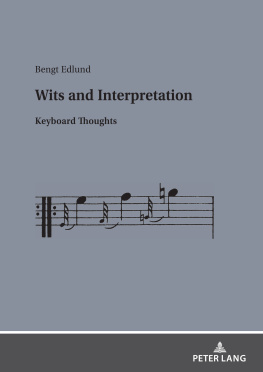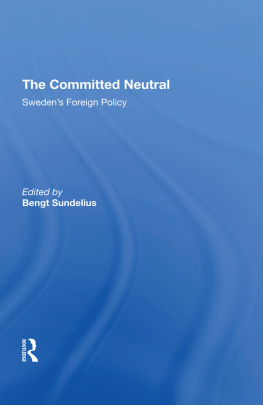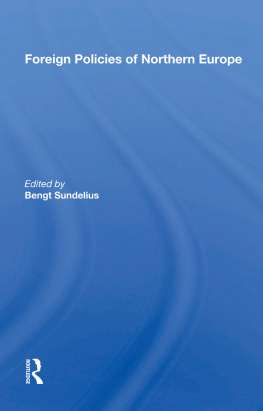Stig Dagerman
A Burnt Child
INTRODUCTION by Per Olov Enquist
Brnt barn (A Burnt Child) was the first book I read by Stig DagermanI think in 1949. It overwhelmed me, and for a long time I wrote my own school essays in the same style that I imagined was his. I read everything by him after that, but nothing was like A Burnt Child.
What was so compelling about this novel about a young man who had an affair with his fathers new wife? Surely it wasnt pornography. And why has this of all his novels divided critics, even today? Olof Lagercrantz, for instance, scarcely mentions it in his classic biography of Dagerman. And the novel has often been accused of having too much Oedipus complex, psychoanalysis, and Freud.
Yet even after sixty years I still cannot see why the book has been overlooked; I must have missed something. I had read, and still read, a remarkably realistic, clear, and poignant story about a young man who insidiously resembles myself.
I still do not understand the criticism. A Burnt Child is truly the Modest Masterpiece. _________
Stig Dagerman had a short life, but his creative life was even shorter. I figure three years and eleven months.
He debuted with Ormen (The Snake) in November 1945: well consider this the starting point. In the fall of 1946 he published De dmdas (Island of the Doomed), a powerful, symbolic novel that enchanted critics (the flying fortress of 1940s literary problems).1 This was followed by the short story collection Nattens lekar (The Games of Night) later the same year. Everyone was talking about Dagerman; he was the genius of the decade. Also in the fall of 1946, he reported on what he saw in bomb-wrecked and famished Germany, where he was on assignment for two months for the newspaper Expressen. This report would be published as a book in the spring of 1947 under the name Tysk hst (German Autumn). The next book he wrote, in the summer of 1948, was A Burnt Child.
It happened fast, an entire novel in six weeks. The time lag between the end of his German expedition and when he resumed writing is particularly notable. A black hole. Nothing for a year and a half. But there was no time to lose! His writing career was so short! Less than four years! Why did he take a break during this frantically prolific period, and what was it that happened?
Apparently nothing. The great success of his German report still an international classic, as no one else wanted to deal with the horrific reality of the defeated Germansled the Expressen editors to find another assignment for him. He would travel to France and write . . . what, exactly? French Autumn? A companion to August Strindbergs Among French Peasants?
France was not Germany: France was a closed country and a victorious power. The success could not be repeated. He spoke excellent German, but his French was lousy. France was like a sealed clam, and as he wandered about the French countryside his debts and feelings of guilt increased. But nothing was written. He was sent out, he was given an advance, but he did not deliver. Yes, the spring was awful, but something else was wrong.
What was the problem? He was in the middle of his writing career, which would end on the tenth of October 1949, when he completed his final novel, Brllopsbesvr (Wedding Worries). By this point, his work had essentially reached its highest creative achievement. And yet as a living, breathing person, Dagerman still had five years left before he would take his own life. Even so, he couldnt write. Three years and eleven months as a writer. And no more.
What happened between December 1946, when he returned home from Germany, and July 1948, when he began writing A Burnt Child and completed it in just six weeks? Why did his style change, moving away from critically acclaimed abstractions with symbolic characters, as in Island of the Doomed, to the caustic, realistic, and spare prose of the summer of 1948? Had reality hit him so hard that he stalled, almost becoming paralyzed?
Lasse Bergstrm made an observation in his foreword to Stig Dagermans Letters that I find quite telling and that covers the entirety of Dagermans resumed careerwhat was left of it:
It is clear that the German experience of 1946 was a turning point. After that, he could no longer express internal fear as freely and naturally as he did in The Snake and Island of the Doomed. His fiction now embraced external reality, as in the novel A Burnt Child. He seems to claim new literary ground but in the process loses the fear that previously had free rein, like a dark beast, in his fiction and in his heart.2
In other words, reality had put the theoretical fear of the forties to the test. What he saw in Germany in the autumn of 1946 were the remains of a war-torn European culture, a landscape in which 660,000 civilian men, women, and children were annihilated by carpet bombs in the final year of the war. He witnessed a state of apathy, doubt, and guiltnot as an expression of intellectual reflection but as, well, simply reality. The young twenty-three-year-old author was jarred out of the typical issues of existential fear, guilt, and culpability facing his fellow Swedish writers of the fortiesthe group known as the Fyrtiotalisternato confront a reality where people were starving and dying amid ruins. He was thus barely able to ask fear-ridden questions about the meaning of lifeor guilt. He identified with the defeated, something that always came naturally to him. He was also now married to a young German woman, a refugee from Nazism: she and her family had given Dagerman the keys to interviews with their surviving relatives in Germany. But they didnt have easy answers to the questions of guilt and responsibility either.
The leap from founder of the flying fortress of 1940s literary problems to witness to the ruins of European misery in Berlin (incidentally, also created by the flying fortress) was great. Dagerman almost didnt succeed. He was sent glowing reviews for Island of the Doomed while in the Ruhr region, and forgetting the famine and hopelessness for a moment, he wrote, I wanted to die of shame but that didnt work out either.3
He later wrote to his publisher about the years that followed, saying that after Germany the joy of writing was gone. But that wasnt all: The foolish year in France may have been devastating. Roaming in solitude from place to place with a journalistic imperative in the backseat and a typewriter in my suitcase that ultimately grew so heavy with failure that I could hardly lift it. Where is the road Im searching everywhere for?4
He finally gave up, notifying the newspaper that a year of French ambitions produced no results, nothing but debts. He secluded himself in a village in Bretagne for six weeks and wrote what would become his most compressed, simple, and poignant novel, which is now after sixty years still read all over the world, the only one, in fact, by any Swedish writer of the forties that is still so prevalent.
A simple novel about a family in Sdermalm in Stockholm. A simple novel about a young two-timer, an angst-filled self-portrait written by a twenty-five-year-old thin-skinned author who couldnt cope with the worlds and his own betrayal, expectations, and declarations of genius. Its also possible that part of the unparalleled charge in this novel is due to the fact that everything in Dagermans life seemed to be falling apart, including his happy marriage. And that he, writing his most personal novel, didnt need to base it on theoretical knowledge of psychoanalysis, Freud, and the Oedipus complex: he had just experienced a shorter intimate relationship with his mother-in-law who had come from Germany by way of the Spanish civil war and who had taught him a lot about reality beyond the literary angst of the Swedish writers of the forties.

